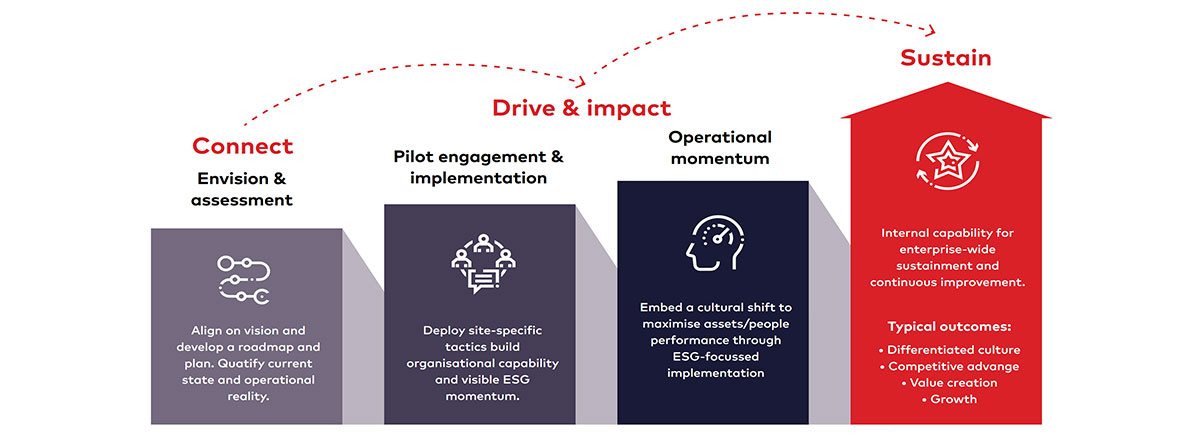ESG in Agrifood
Companies in the agriculture, food and beverage industry today can feel as if they are operating under a microscope with stakeholders scrutinising every development impacting the organisation and every decision made by company leadership. These companies face significant headwinds as they attempt to successfully navigate an increasingly uncertain future while providing an adequate financial return to shareholders. More and more, companies are being held accountable for their environmental, social, and corporate governance (ESG) activities. By incorporating ESG into the business strategy, companies can achieve positive outcomes for the safety and health of employees, the environment, and financial performance.

ESG drives enterprise value and strengthens culture in agrifood…if implemented correctly
Those that fall short of stakeholder expectations face greater scrutiny. A recent example is Brazil-based JBS SA, the world's largest meat supplier. Global environmental concerns over deforestation of the Amazon and recent criticism over large outbreaks of COVID-19 among workers in its U.S. plants placed JBS in a challenging position. JBS saw its stock price trend toward its "steepest annual decline in a decade".1 JBS recognised it has an important role to play in addressing these issues and has placed ESG as a top priority. As an immediate action, JBS invested over $520 million to enhance employee safety measures and to support local communities during the pandemic. JBS also announced a program to monitor indirect cattle sources more effectively to combat deforestation. By incorporating and executing ESG measures in its business strategy and operational model, JBS SA delivered a strong financial performance in Q3 2020.2
Consumers and communities are becoming much more environmentally conscious, and they expect brands to reflect their concern for environmental stewardship without compromising on product experience. This significantly impacts agriculture, food, and beverage companies across the value chain, particularly as it relates to product portfolios and packaging. In addition, raising and feeding animals requires animal protein suppliers to use large acreages of land, which contributes to deforestation and climate change. The logistics of transporting raw materials and final products around the globe also contributes to climate change. According to the World Bank, agriculture is the source of about 80 percent of global deforestation, 24 percent of global annual greenhouse gas (GHG) emissions, and rising food production is expected to require 40-50% more water in the coming years.3
Protecting the health and welfare of workers is another critical element of ESG. Many agriculture, food, and beverage companies are under intense scrutiny to ensure safe labor conditions for employees. This year some meat processing plants, especially in the U.S., experienced outbreaks of COVID-19 among workers. In today's society of "always on" social media, accidents and safety violations can be broadcasted to consumers and investors with the touch of a screen.
Also, unfair payments to farmers and the use of child labor are still realities in certain areas. The U.S. Department of Labor estimates that 1.56 million children are currently engaged in hazardous work in the cocoa industry, for example.4
ESG as a value driver
Given these increasing expectations, today more than ever companies should incorporate ESG into their business strategy and planning. Improving ESG performance – the impact of operations on the safety and health of the workforce, the environment, and the surrounding communities - can directly lead to improved business performance and profitability in an organisation. Unfortunately, many companies don't focus on ESG because of the incorrect assumption that devoting the necessary time and resources to planning and operationalising ESG measures are too costly.
However, prioritising ESG can be a profit and value driver for companies. In fact, studies show that companies focusing on ESG are more profitable in the long run. In one of the most comprehensive studies on the subject conducted so far, an analysis by Deutsche Bank in 2015 found that of more than 2,200 studies since 1970, 63 percent found a positive link between ESG performance and financial performance.5 Considering ESG can reduce manufacturing waste, lower energy consumption, and increase its energy efficiency, these are direct bottom line impacts that help to increase profit potential. This is important as the costs of raw materials and energy will continue to grow as the world economy expands and as rapidly industrialising countries, such as China and India, make strong demands on these resources. Investors are also equating business performance and shareholder value to ESG.
According to the Center for Disease Control (CDC), among 23 states reporting COVID-19 outbreaks in meat and poultry processing facilities, 16,233 cases in 239 facilities occurred, including 86 COVID-19–related deaths.6
Successfully implementing ESG in an organisation
Those companies that manage their business through an ESG lens will realise positive outcomes for the health and safety of employees and operations, achieve improved business performance and become more resilient organisations.
But successfully integrating ESG across the organisation requires much more than simply a decision by company leadership and new policies for employees.
It involves careful strategic and tactical planning, operational discipline, committed company culture, and sustainable implementation if an organisation is to achieve lasting benefits and competitive advantage. Many organisations today are struggling to maintain momentum and focus on ESG. In our conversations with leading multinational companies and investors, their biggest challenge has been gaining and maintaining traction for ESG in their organisations. At dss+, we have developed a roadmap for organisations to follow and overcome the challenge. (See Figure 1)

Figure 1: dss+ roadmap for ESG excellence
As one moves along the ESG excellence roadmap from envision and assessment, to operationalising ESG impact, to sustaining and continuously improving ESG outcomes, there are three elements in particular that are critical to achieving successful and lasting ESG implementation: 1) Create a vision and culture to connect with employees, 2) Assess current state and operational reality, and, 3) Effectively integrate ESG into operations to sustain improvements.

1 Create a vision and culture to connect with employees
A company culture where a common vision leads and unites personnel at all levels to commit to ESG improvements is essential for a successful implementation.
A clear vision of ESG to guide leadership and employees creates a connection and sense of inclusion within the organisation. This also guided Firmenich, the world's largest privately-owned perfume and taste company, which has received a number of awards and accolades based on its commitment and comprehensive approach to ESG and the UN Sustainable Development Goals. Firmenich has been commended for taking a long-term approach through its vision to create value for its shareholders by making a positive difference, from making healthier food options to using 100% renewable electricity in the majority of its operations.7
Furthermore, without a demonstrated and ongoing commitment to ESG by company leadership, employees won't take the new initiative seriously. Therefore, leadership and management need to be enabled to reinforce the importance of ESG within the organisation. Training and engagement workshops across all levels should take place frequently. A careful and unified cultural implementation will lead to higher employee engagement, lower risk of non-compliance, and stronger organisational alignment.
Additionally, to achieve desired ESG outcomes required for the cultural implementation, buy-in and the establishment of the respective mindsets and behaviours among employees across the organisation are critical. This management of change is achieved by taking steps to provide a clear understanding of the benefits of ESG to the company and, by extension, to individuals. This can be assisted by regularly capturing the employee's perception via surveys and interviews.
Finally, it is important to take cultural implementation beyond the company walls and include various stakeholders. This requires establishing effective methods of communication of the company's ESG goals with each stakeholder, who often have a different set of priorities and values, to get their understanding, acceptance, and eventual execution of necessary processes. Bringing these stakeholders along a company's journey to ESG excellence will enable them to build capabilities together along the value chain and achieve ESG improvements by acting together.

2 Assess current state & operational reality
An effective assessment requires a thorough examination of the current state and unique ESG risks facing the organisation, as well as their potential impact on the ability of the company to continue normal operations.
Knowing the organisations risks is the first step to mitigating and increasing the resiliency of the business processes. This involves analysing the broad range of potential threats to the organisation, such as:
- Operational risks: resource and asset efficiency, potential environmental impacts of operations (e.g. waste and GHG emissions), and any possible impact on the safety of employees and surrounding communities
- Supply chain risks: material sourcing, potential environmental impacts through transportation, and worker rights and safety along the supply chain
- The health and nutrition risks of products made by the company: potential negative impacts on consumers, including any potential contribution to obesity or other unhealthy impacts
- Product quality and safety risks: quality of ingredients and potential product recalls
- Product labelling and marketing risks: potential exposure in controversial markets or risks associated with any health claims made about its products
- Packaging lifecycle risks: single-use packaging waste or packaging recycling
The risk of being held liable or found negligent for accidents or environmental damages that occur, even when a company acts prudently, should be considered, as well.

3 Effectively integrate ESG into operations to sustain improvements
Implementing ESG into a company's operations requires fully integrating it among all existing processes.
Doing so will impact operational risk management and lead to higher performance. For example, in the area of process analysis, numerous ESG improvements are now possible that go far beyond simple heat recovery or known measures such as pump controls. The greatest potential for benefit typically lies in process management. ESG can also lead to recognisable improvements in efficiency, from resource efficiency that results in reductions in physical waste (the volume of discarded resources and materials) to operational efficiency that results in optimal performance of processes, systems, and equipment.
|
dss+ Case Study As a result of the engagement, each of the 3 sites achieved top marks in safety performance, operations/manufacturing performance and employee engagement across all of the manufacturer's 50 global sites. Following this success, dss+ is now implementing the program across all sites. |
Conclusion
Integrating ESG as a way of doing business is no longer optional and in fact, it should be embedded in the daily business activities and culture of an organisation. Successful implementation of ESG strategy requires the three critical elements of creating a vision and culture that embraces ESG, assessing risks and impact, and integrating ESG into operations to become a more resilient organisation. In doing so, agriculture, food & beverage companies will not only drive their own enterprise value and financial success but also and, most importantly, deliver a positive impact on the health and wellbeing of our communities and planet.